Ryan Hall's Blog, page 272
April 1, 2016
Meseret Defar, DeAnna Sodoma Heading to the Carlsbad 5000 Hall of Fame
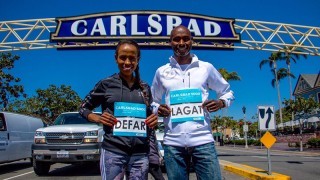
Defar (left) will be inducted into the Carlsbad 5000 Hall of Fame along with DeAnna Sodoma.
Meseret Defar wandered 9,149 miles from Addis Ababa, Ethiopia to make her first appearance at the Carlsbad 5000 in 2002. She was 18.
The first time Deanna Sodoma raced at the event she traveled all of 5.6 miles. But in truth, Sodoma’s path to Carlsbad was much more arduous than Defar’s.
Saturday morning after the Junior Carlsbad children’s races, Defar and Sodoma, women from opposite sides of the world, one a two-time Olympic gold medalist from Africa, the other an American wheelchair racer, will be inducted into the Carlsbad 5000 Hall of Fame.
Here’s a closer look at the two women.
Meseret Defar
Defar has raced at Carlsbad six times and will compete again Sunday. She was 11th in her 2002 debut as an 18-year-old. Then came a fifth in 2003, third in 2004 and victories 2006, 2007 and 2010.
She set the outdoor 5K world record during her 2006 victory, winning in 14 minutes, 46 seconds.
Her 5,000-meter Olympic gold medals came in 2004 at Athens and 2012 in London. She earned bronze at the 2008 Beijing Games.
“As a race organizer she is everything that you ever dream of,” said Tracy Sundlun, Carlsbad 5000 executive director. “She came here in her first year as a developing junior athlete as a request from some of our coach and athlete friends in Ethiopia.
“She finishes 11th. She didn’t make a dime. Two years later she’s the Olympic champion at 5,000 meters. She has come back, and we’ve been intertwined ever since.”
Defar was particularly close to the late Mike Long, who recruited professional runners for the Carlsbad 5000 and Rock ‘n’ Roll Marathon. Long died in 2007.
“In 2010, when Meseret received the Mike Long trophy for winning Carlsbad, she had tears in her eyes,” Sundlun said. “I’m hopeful that when she receives her Hall of Fame award, which is a duplicate of that Mike Long trophy, she will have tears in her eyes again.”
Defar was moved about being inducted into the Hall of Fame.
“I can’t believe 10 years have passed since I set the world record in Carlsbad,” said Defar, who’s now 32 and became a mother last year. “A lot has happened to me on and off the track since then, but it remains a race which is close to my heart.”
DeAnna Sodoma
The year was 1989. Sodoma was 21 years old. Before being hit by a car while cycling six months earlier, Sodoma was living the active Southern California lifestyle—running, racing triathlons, attending college.
“Like every 21-year-old,” said Sodoma, now 48, who lives in Escondido and is the mother of three boys.
After the bike accident, numbness in Sodoma’s legs crept up her body until March 9, 1989, when she could no longer walk, the result of a spinal cord condition.
“My dead leg anniversary,” she calls the day.
Steve Scott, America’s greatest miler and winner of the first three Carlsbad 5000s, talked to patients rehabbing at Tri-City Medical Center days before the 1989 Carlsbad 5000 and a wild idea crept into Sodoma’s head.
“I wonder if I could get out of here and do this race?” she asked herself.
Granted a 12-hour pass, Sodoma made it from the hospital to the Carlsbad 5000 start line and pushed her way across the 3.1-mile course.
“I think it took me an hour,” she said.
Sodoma developed into one of the United States’ best female wheelchair racers, winning bronze medals at the 1992 Paralympics in Barcelona in the 10,000 and marathon. While Sodoma excelled at long distances, she earned her share of gold at Carlsbad, too, winning seven times, the last in 2002. She set four world records at Carlsbad.
Regarding the Hall of Fame honor, Sodoma said, “It’s nice to be recognized. It’s very heartwarming. I feel honored.”
As to what motivated her after losing the use of her legs, Sodoma said, “I wasn’t finished. I knew my story wasn’t finished.”
Today, she snorkels, water skis, snow skis and has jumped out of an airplane.
“I think it’s in my DNA,” Sodoma said. “We’re Norwegian. We’re like grrrrrrr. We conquer and take over and compete.”
The post Meseret Defar, DeAnna Sodoma Heading to the Carlsbad 5000 Hall of Fame appeared first on Competitor.com.
Shoe Talk: Adidas Terrex Skychaser GTX
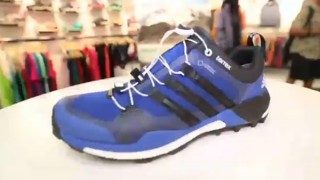
Adidas’ latest off-road shoe offers the durability of a trail shoe with its innovative Boost technology.
RELATED: Shoe Talk: Brooks PureFlow 5
The post Shoe Talk: Adidas Terrex Skychaser GTX appeared first on Competitor.com.
March 31, 2016
World-Record Holder Meseret Defar Back at the Carlsbad 5000
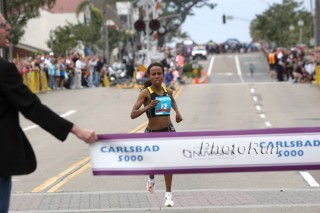
Meseret Defar is a Carlsbad 5000 veteran with a world record and three wins (including here, in 2010). Photo: PhotoRun.net
Spring is a time for lacing up the flats and taking to the roads, and on Sunday some of the fastest runners in the world will be lining up in one of the most scenic locales, the seaside town of Carlsbad, California to compete in the ultimate pavement race: the 31st edition of the Carlsbad 5000.
In the women’s division, Ethiopia’s Meseret Defar will be the clear runner to beat. Defar, 32 years old, is arguably one of the best runners at the 5K distance ever, having won two Olympic gold medals in that distance on the track. The Ethiopian has dominated at Carlsbad three times. And in 2006, she set the still-standing fastest road 5K time in the world, 14:46. “I can’t believe 10 years have passed since I set the world record in Carlsbad,” Defar said. “A lot has happened to me on and off the track since then, but it remains a race which is close to my heart for many reasons”.
After her Olympic win in 2012, Defar took a hiatus from the sport to start a family. “Since the birth of our daughter Gabrielle last year I’m now back racing well and my indoor performances show me that I am ready to run well, run fast and hopefully post another quick time,” she said. “I’m excited for the rest of the year, I’m looking forward to Carlsbad as my next challenge before turning attention to the track and the Rio Olympics.”
Ethiopia’s famed rival, Kenya, will have athletes at the starting line on Sunday–most notably, the woman wearing bib F2, Caroline Kipkirui, who is a rising star in her country. The 21-year-old Kipkuri owns a 15:24 personal best for 5000m. Another Kenyan expected to give Defar a run for the money is former Florida State standout Violah Lagat who has run 15:35 for the 5000m and has been setting personal bests in the shorter distances (1500m and mile) this year, which might be indicative of speed for Sunday’s race.
The United States has two aces toeing the line: Alisha Williams of Golden, Colorado and Jen Rhines of Boston. Williams has a sub-15-minute personal best (14:58) and has shown versatility by running PRs in the 10,000m and the 10-mile last year. Jen Rhines is a three-time Olympian and set her PR in Carlsbad back in 2007 (15:21). She will be attempting to set a new U.S. Masters record (15:48) on the speedy and scenic course.
The Carlsbad 5000 is a signature Rock ‘n’ Roll event and isn’t limited to elites. In fact, the fun starts with the Junior Carlsbad pre-registration party on Friday. That next day, 1,500 young runners ages 12 and under will give it their best in 11 age-group races.
Sunday is all about the 5K as participants earn their finisher medal. Runners over 21 will have the opportunity to celebrate in style at the beer garden with some free brews thanks to Pizza Port. Live music, sunshine, cool ocean breeze, and plenty of on-course entertainment will make this year’s Carlsbad 5000m the race to be at this weekend.
The post World-Record Holder Meseret Defar Back at the Carlsbad 5000 appeared first on Competitor.com.
Out There: The Music That Sticks With Us
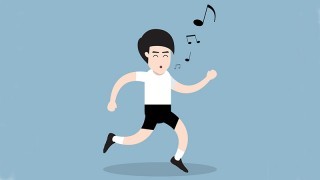
Why do certain songs get stuck in our head when we run?
I don’t listen to music when I run. Instead, I use my workouts as a time to be in my own head without distraction. I think about what I’m going to write in this column, solve problems that have nagged at me for days, decide what I want for dinner, or hash out theories about Game of Thrones in my head (this occupies about 75 percent of my waking thoughts).
But sometimes—and this may or may not shock you—there’s nothing in my head. I’ve got nothing to think about. It’s just me and the sound of my feet hitting the trail:
Tap-tap-tap-tap
Inevitably, the rhythm becomes percussion, which becomes a song:
I want my baby-back baby-back baby-back
And it’s at this time I wish I ran with an MP3 player, because I’m pretty sure I would come up with a playlist that doesn’t involve the jingle for Chili’s (baby-back riiiiiibs! Bar-be-cue sauuuce!).
It’s not always commercial jingles that play between my ears. I get a lot of 90’s pop music, too. Sometimes, it’s Rodgers and Hammerstein show tunes (yes, I said show tunes. I will come down and fight you right now.) This morning’s run—all 18 miles of it—was accompanied by Wild Cherry:
Play that funky music, white boy
Play that funky music right
Play that funky music, white boy
Lay down that boogie and play that funky music ‘til you die.
Don’t look at me like I’m strange. You know you’ve got a few earworms of your own. A study from the Proceedings of the 10th International Conference on Music Perception and Cognition found that more than 90 percent of people have an earworm at least once a week; about a quarter have them daily. What’s interesting is that no one has the same earworms. You might be singing “Safety Dance,” while the guy running next to you wants to know “Who Let The Dogs Out?” (Who? Who-who-who?).
The phenomenon, described charmingly by musical researchers as “musical hallucinations,” is widespread but not fully understood. Some experts suggest earworms are triggered by a sound—hearing a Taylor Swift song when someone says “Starbucks,” for example, or the footfalls of your run percussing an Outkast piece. Emotions may have something to do with it, too: if you associate a certain song with a certain emotional state, your brain is likely to play that song when you feel that emotion. That’s probably why Cee-Lo Green and his catchy (yet not-fit-for-print) lyrics always seem to make an appearance when I’m just about to bonk.
At best, continuous loops can be amusing; at worst, they play Nickelback until you beat your own skull into a coma. Many runners have an earworm or two that makes an appearance in conjunction with the beat of their feet. Gloria Estefan was right: the rhythm is gonna getcha.
It’s not all bad, though. You can use earworms to your advantage. Running coach Jack Daniels once noted that the world’s best marathoners have a leg turnover of about 180 steps per minute—such a rhythm forces runners to take shorter, lighter steps, therefore improving efficiency and reducing injury. 180 beats per minute is The B-52’s “Rock Lobster” or Missy Elliot’s “Get Your Freak On.” If you’re going to going to have an earworm, strive for an uptempo one.
But if you really want to get rid of the song in your head (say, around mile 15 of baby-back baby-back baby-back ribs) some experts say thinking of a different song can help (though choose wisely; that song can also become an earworm of its own), as can singing the entire song to get past the 10-second chorus repeating in your head. One study says chewing gum may disrupts the part of the brain that activates while playing earworms.
If all else fails, you might as well embrace it. Lay down that boogie and play that funky music ‘til you die.
(You’ve got that stuck in your head now, don’t you?)
* * *
About The Author:
Susan Lacke does 5Ks, Ironman Triathlons and everything in between to justify her love for cupcakes (yes, she eats that many). Susan lives and trains in Salt Lake City, Utah with three animals: A labrador, a cattle dog, and a freakishly tall triathlete husband. She claims to be of sound mind, though this has yet to be substantiated by a medical expert. Follow her on Twitter: @SusanLacke.
The post Out There: The Music That Sticks With Us appeared first on Competitor.com.
Billionaire Branding: Brooks Releases New Berkshire Hathaway/Warren Buffett Running Shoes
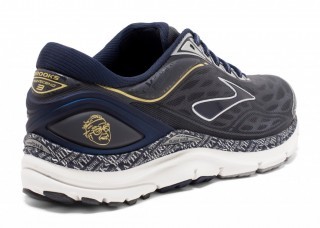
Brooks has released images of the new Berkshire Hathaway running shoe—a special edition of the Transcend 3 stability/support shoe it developed in honor of its parent company and its CEO and chairman, Warren Buffett. (Seattle-based Brooks Sports Inc. is a wholly owned subsidiary of Berkshire Hathaway Inc.) The shoes will be sold for $170 at the Berkshire Hathaway annual shareholders meeting at the end of April in Omaha, Neb., just before the annual Invest in Yourself 5K on May 1. The shoe features a caricature of Buffett on the heel and “Berkshire Hathaway” printed on the guide rail and on the upper. Past versions of a special Berkshire shoe have included the Adrenaline GTS 12, PureCadence 2, Transcend and Glycerin 12. The shoe has an 8mm heel-toe offset (31mm/23mm for men, 29mm/21mm for women) and weighs 10.9 oz for a men’s size 9 and and 9.5 oz for a women’s size 7.0. Scroll through the images below to see the men’s and women’s versions of the shoe.
Photo Gallery
1 of {count}
Back to Start
View Larger Image

Brooks Berkshire Hathaway Transcend 3
View Larger Image

Brooks Berkshire Hathaway Transcend 3
View Larger Image

Brooks Berkshire Hathaway Transcend 3
View Larger Image

Brooks Berkshire Hathaway Transcend 3

More Galleries
The post Billionaire Branding: Brooks Releases New Berkshire Hathaway/Warren Buffett Running Shoes appeared first on Competitor.com.
The Do’s and Don’ts of Wildlife Encounters on the Trail
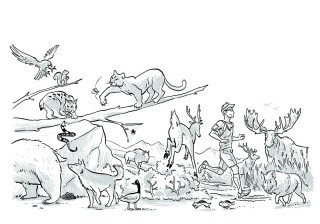
All Illustrations by Charlie Layton
Running on trails almost guarantees you some interaction with wildlife, and that’s a wonderful thing. The likelihood of a safe wildlife encounter is far greater than an unsafe wildlife encounter. However, there is potential for a meeting with a predator, a snake or any animal that feels a need to defend itself. Here are some very general guidelines on how to stay safe and defuse potentially unsafe situations in the wild.
Coyotes
DO
Stay calm, keep your dog on a leash and back away slowly.
Stop running, stand tall, and yell if a coyote(s) sees you and appears to be sizing you up.
Throw something to scare it away, but don’t actually hit it.
Make eye contact if the coyote is alone, and back away slowly.
DO NOT
Turn your back and run away or let your dog give chase.
Act threatening or look any of them in the eye if you are facing a pack.
The post The Do’s and Don’ts of Wildlife Encounters on the Trail appeared first on Competitor.com.
The Right Way to Grab a Water Cup
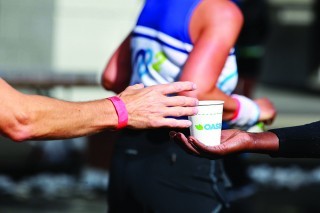
Photo: Photorun.net
Drinking water doesn’t seem complicated, but when you’re trying to do it in the middle of a race, things can suddenly get tricky. These simple suggestions will help you get through aid stations quickly and effectively, even in your marathon-induced haze.
Plan ahead
Check out the race maps beforehand to see where the aid stations are so you can plan your fueling strategy—specifically the types of fluids and fuel you take in at each aid station. As you approach an aid station, check to see which areas look crowded and which volunteers look ready.
“Practice as much as you can,” says Jeff Gaudette, head coach and founder of RunnersConnect. Gaudette often sets up a table at the track and practices grabbing water cups during a workout. You can also recruit fellow runners or kids to hand the cups to you, he says.
Grab the cup
When entering an aid station: “Pay attention to how the volunteers are holding the cups,” Gaudette explains. Ideally, take one from someone pinching the rim or letting the cup sit flat on their palm. If they’re holding the cup too tightly, it may be hard to grab as you run past.
The crowds at the start of the aid station can sometimes be daunting, Gaudette says, but if you aim to grab a cup early, you’ll have time to try again or grab a second one.
Drink!
Once you have the cup in hand, don’t grip it in an open hand. Instead, pinch the rim together at the top to create a spout that will allow you to run and sip without splashing or getting water up your nose.
Avoid trouble
The biggest problem isn’t the drinking; it’s that everyone is trying to do the same thing as you. Don’t stop running once you get your cup—and watch out for people who do. Also, try to avoid zigzagging across the road or through crowds.
“You need to watch out for cups on the ground because they’re really slippery,” Gaudette says. If it’s cold, spilled water can freeze on the road too, adding an extra challenge.
RELATED: What Dehydration Does to Your Running Form
The post The Right Way to Grab a Water Cup appeared first on Competitor.com.
Photos: 2016 Boston Marathon Special Edition Shoes
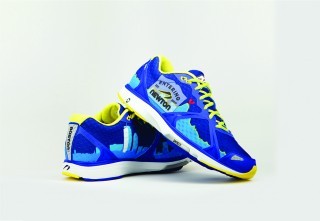
In recent years, shoe brands have created special editions to celebrate the Boston Marathon. Here are some of the new models that will be dropping at the Boston Marathon race expo and Boston area running stores in the week prior to this year’s race on April 18.
(Each of these special edition models is $10–$20 more than the standard version.)
Photo Gallery
1 of {count}
Back to Start
View Larger Image

Newton Fate 2 Boston, $150
View Larger Image

Brooks Nantucket Adrenaline GTS 16, $130
View Larger Image

New Balance Fresh Foam 1080 Boston, $165
View Larger Image

Nike Zoom Streak LT 3 BOS, $95
View Larger Image

Skechers Performance GoRun Forza, $115
View Larger Image

Saucony Green Line Kinvara 7, $120
View Larger Image

Nike LunarEpic Flyknit BOS, $190
View Larger Image

Saucony Green Line Triumph ISO 2, $160
View Larger Image

New Balance Fresh Foam Zante v2 Boston, $115
View Larger Image

Nike Free RN Distance BOS, $135
View Larger Image

Skechers Performance GoMeb Speed 3, $120
Related Galleries

Sneak Peek: 2015 Special-Edition Boston Marathon Shoes

More Galleries
The post Photos: 2016 Boston Marathon Special Edition Shoes appeared first on Competitor.com.
Trail of the Week: Laugavegur Route, Iceland
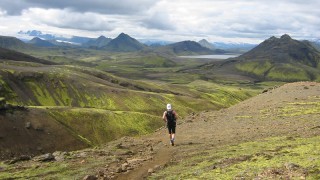
Our Trail of the Week feature is made possible through a partnership with Trail Run Project, a crowd-sourced collaboration by and for the running community. Thanks to Brian Smith for mapping and describing this route.
Iceland is the kind of destination that is best experienced with a tour company and guide. With routes and trails that interconnect through remote mountains, local knowledge and pre-planned logistics are invaluable.
The Laugavegur Route is a mind-blowing, multi-day overland route in the highlands of Iceland. On this point-to-point hut adventure you’ll follow singletrack through a multitude of landscapes including geysers, multicolored rhyolite mountains, bubbling mud, endless lava fields and glaciated mountain vistas.
The trip can be broken down into three long days or five shorter days. The last day from Þórsmörk to Skogafoss is truly epic and travels between two major glaciers and across the slopes of a cooling volcano. This day is only for those who are very fit and very adventurous.
The highlands region is a remote and exposed environment. Expect the weather to change quickly and be prepared with extra layers, waterproof gear, as well as plenty of food and water. Snow is possible in the summer months of July and August.
A GPS unit is a good bet to help with navigation when the weather rolls in and visibility could become limited.
RELATED: Iceland’s Laugavegur Ultra Marathon
The Data
Miles: 52.0
Runnable: 90 percent
Average Grade: 6 percent
Max Grade: 69 percent
Total Ascent: 7,331 feet
Total Descent: -9,186 feet
Highest Elevation: 3,484 feet
For a closer look, check out the interactive map, data, photos and virtual run simulator courtesy of Trail Run Project:
The post Trail of the Week: Laugavegur Route, Iceland appeared first on Competitor.com.
March 30, 2016
Carlsbad 5000 Alters Elite Course for 2016
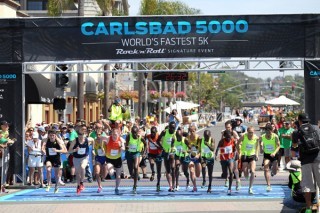
The Carlsbad 5000 is billed as the world’s fastest 5K and rightfully so. Sixteen world records and eight U.S. records have been set on the course that overlooks Pacific Ocean waves breaking on the beach. But if you’re Tracy Sundlun, the event’s executive race director, you’re always tinkering, always looking for ways to improve.
For Sunday’s 31st edition of the race affectionately known as the ’Bad 5K, Sundlun has tinkered some more. For the second year in a row the course has been significantly altered for the professionals.
A year ago, Sundlun introduced two loops along Carlsbad Boulevard, giving the thousands of spectators more opportunity to cheer the elites. This year, the start is being moved from Carlsbad Village Drive to Carlsbad Boulevard. Plus, mimicking track and field, the professionals will run the two loops on Carlsbad Boulevard counter-clockwise.
“Even for those athletes as beautifully efficient as Bernard Lagat, they backed off before every turn,” said Sundlun. “They went into them running clockwise, which is not what they’re used to doing on the track. They’ve spent all their lives running counter-clockwise.”
The new layout is only for the pro runners and wheelchair athletes. Age-groupers will still run the course that essentially has stayed the same since the race’s 1986 inception.
The changes were incorporated for two reasons—to enhance the spectator experience and create a course and environment that’s more beneficial for the elite runners.
The start will be just south of the Carlsbad Boulevard and Carlsbad Village Drive intersection, amid the heart of the spectators.
For last year’s 30th anniversary the start of the professional races was moved to where the race finishes on Carlsbad Village Drive. After consulting with runners and coaches, it was determined that the runners didn’t have enough of a build-up before the turn on Carlsbad Boulevard, where the runners were quickly met with a slight elevation gain.
“It didn’t help the athletes,” said Sundlun.
Paul Greer, head coach of the San Diego Track Club, likes the changes.
“What moves athletes to break records or run great times is tremendous spectator participation,” Greer said. “The advantage Tracy gave the athletes this year is putting them in the midst of the crowd. I think it’s going to have a stadium feel to it. The runners, they’ll actually feel the crowd as well as hear them.”
As usual, elite athlete recruiter Matt Turnbull has pulled together a deep set of pro runners. Defending champion Lawi Lalang of Kenya returns to defend his title. The ageless Lagat, 41, is back after setting the masters 5K road record last at Carlsbad, finishing in 13:40. A young runner to keep an eye on is 19-year-old Debeli Gezmu. Meseret Defar’s cousin, Gezmu has been clocked in the 5,000 on the track in 13:29.81.
On the women’s side, Defar is back. The two-time Olympic 5,000-meter champion set the women’s course record at Carlsbad 10 years ago, running 14:46. Defar is expected to be pushed by 21-year-old Kenyan Caroline Kipkirui, who owns a 5,000-meter track best of 15:24.66.
Sunday’s racing begins at 7 a.m. with the masters events.
On Saturday, the Junior Carlsbad 5000 1-mile races begin at 7:20 a.m. Added to this year’s schedule is an adult one-mile race offering $3,000 in prize money.
The post Carlsbad 5000 Alters Elite Course for 2016 appeared first on Competitor.com.
Ryan Hall's Blog
- Ryan Hall's profile
- 21 followers



